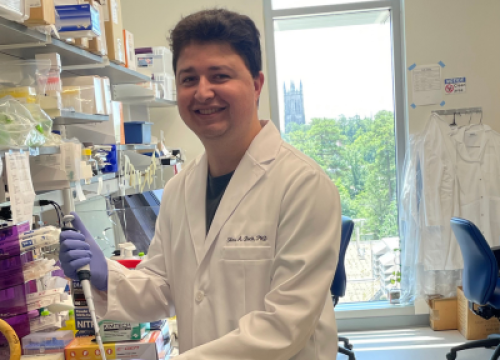Non-invasive Focused Ultrasound Helps Alleviate Parkinson’s Symptoms

A clinical trial shows that an ultrasound treatment can help with involuntary and impaired movement for people with Parkinson’s.
People with Parkinson’s disease (PD) experienced significant improvement in tremors, mobility, and other movement symptoms after undergoing a minimally invasive procedure using focused ultrasound, a study published in the New England Journal of Medicine shows.
Deep brain stimulation (DBS) has become the main surgical treatment for people with PD who do not fully respond to levodopa. It involves the invasive surgical placement of tiny wires into the targeted brain area, which is then stimulated by sending electrical signals through the wires. Focused ultrasound is a treatment that emits high-intensity sound waves into the brain, guided by magnetic resonance imaging (MRI). Where these waves cross, they create high energy, which creates heat, destroying a specific area in the brain connected to tremor. It is considered non-invasive because it does not involve incisions or holes in the skull.
Both treatments have pros and cons.
- Focused ultrasound is non-invasive. It does not require additional adjustments and creates a permanent change.
- DBS is an invasive surgery that allows for adjustments as movement symptoms worsen through the course of Parkinson’s, even years after surgery. DBS can still be an option for those who undergo focused ultrasound if the disease continues to progress.
The U.S. Food and Drug Administration (FDA) approved focused ultrasound as a Parkinson’s treatment for those with movement symptoms mainly on one side of the body. However, most people with Parkinson’s have movement symptoms on both sides of the body. This study included people who have symptoms on both sides of the body.
About the Study & Results

The focused ultrasound targets a part of the brain called the globus pallidus internus (GPI), which is part of the basal ganglia, a network of brain structures that controls movement. In Parkinson’s, the loss of dopamine-producing neurons disrupts the normal functioning of the basal ganglia. This can ultimately lead to abnormal activity in the GPI and can contribute to the movement symptoms of Parkinson’s.
This study examined the safety and efficacy of focused ultrasound of the GPI in a randomized trial of 94 participants with PD movement symptoms. Only the side of the brain opposite the participant’s most symptomatic side was treated. Of the 94 participants, 69 were randomly selected to undergo the procedure, with 25 receiving the false treatment as a control.
Each participant received a clinical assessment for the severity and progression of their Parkinson's before and after treatment. Nearly 70% of participants in the treatment group had improvements in symptoms after three months of follow-up, compared to 32% in the control group who had an inactive procedure without focused ultrasound.
One year later, a follow-up assessment tracked 60 of the original 69 participants and found that 66% of those who received treatment and initial improvement in symptoms continued to have a positive response to the treatment. Additionally, of the 25 participants who initially had a placebo treatment, 20 chose to undergo treatment three months later. Of the 20 that chose treatment, 70% had a positive response at three months, and 57% had continued success one year later.
A third of the participants had no side effects. Among those who did, most participants experienced only some mild to moderate symptoms, including headaches, dizziness and nausea. However, one person experienced a serious complication related to the procedure: a nonfatal pulmonary embolism. At the three months check-up, adverse reactions were mild to moderate and included slurred speech, disturbances in walking, loss of taste, visual disturbance and facial weakness.
Highlights
- The clinical trial used focused ultrasound to target movement symptoms of participants with Parkinson’s with the goal of improving them.
- Nearly 70% of participants in the treatment group responded successfully to treatment after three months of follow-up, compared to 32% in the control group who did now undergo the focused ultrasound.
- About 66% of participants in the treatment group who had initial success continued to have a positive response from the treatment a year later.
What does this mean?
This treatment may be effective for improving physical symptoms of Parkinson’s. However, the long-term effects of the procedure are still not known. All participants in the study will be followed for five years to assess the effects and long-term safety of the procedure.
What do these findings mean to the people with PD right now?
Although approved by the FDA, it will be years before we know the long-term effectiveness and impacts of focused ultrasound as a PD treatment. The Parkinson’s Foundation encourages people with PD to work with a movement disorders specialist to make sure a focused ultrasound is a good option.
There are an increasing number of sites offering focused ultrasound for Parkinson’s across the country. For a list of sites that offer the treatment, visit the Focused Ultrasound Foundation website. Be sure to ask about the site’s experience with treating Parkinson’s disease, specifically.
Of note, focused ultrasound is not universally covered by Medicare — eligibility and region vary when it comes to Medicare reimbursement. It will take time for the procedure to become more widely available and to be covered by insurance. Directly contact the center offering focused ultrasound in your area for specific information about insurance coverage.
Learn More
The Parkinson’s Foundation believes in empowering the Parkinson’s community through education. Learn more about PD and the topics in this article below, or by calling our free Helpline at 1-800-4PD-INFO (1-800-473-4636) for answers to your Parkinson’s questions.
Related Materials
Pain in Parkinson's Disease
Occupational Therapy and PD
Nutrition and PD
Related Blog Posts


Neuro Talk: What’s Next for PD Research
